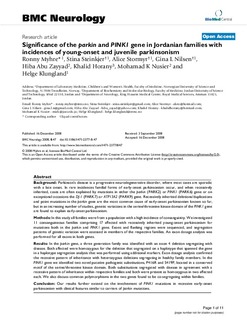| dc.contributor.author | Myhre, Ronny | |
| dc.contributor.author | Steinkjer, Stina | |
| dc.contributor.author | Stormyr, Alice | |
| dc.contributor.author | Nilsen, Gina Lillemork | |
| dc.contributor.author | Zayyad, HA | |
| dc.contributor.author | Horany, K | |
| dc.contributor.author | Nusier, Mohamad K | |
| dc.contributor.author | Klungland, Helge | |
| dc.date.accessioned | 2015-09-25T11:44:20Z | |
| dc.date.accessioned | 2015-10-05T09:26:26Z | |
| dc.date.available | 2015-09-25T11:44:20Z | |
| dc.date.available | 2015-10-05T09:26:26Z | |
| dc.date.issued | 2008 | |
| dc.identifier.citation | BMC Neurology 2008, 8(47) | nb_NO |
| dc.identifier.issn | 1471-2377 | |
| dc.identifier.uri | http://hdl.handle.net/11250/2178769 | |
| dc.description.abstract | Background: Parkinson's disease is a progressive neurodegenerative disorder, where most cases are sporadic
with a late onset. In rare incidences familial forms of early-onset parkinsonism occur, and when recessively
inherited, cases are often explained by mutations in either the parkin (PARK2) or PINK1 (PARK6) gene or on
exceptional occasions the DJ-1 (PARK7) or ATP13A2 (PARK9) gene. Recessively inherited deletions/duplications
and point mutations in the parkin gene are the most common cause of early-onset parkinsonism known so far,
but in an increasing number of studies, genetic variations in the serine/threonine kinase domain of the PINK1 gene
are found to explain early-onset parkinsonism.
Methods: In this study all families were from a population with a high incidence of consanguinity. We investigated
11 consanguineous families comprising 17 affected with recessively inherited young-onset parkinsonism for
mutations both in the parkin and PINK1 gene. Exons and flanking regions were sequenced, and segregation
patterns of genetic variation were assessed in members of the respective families. An exon dosage analysis was
performed for all exons in both genes.
Results: In the parkin gene, a three generation family was identified with an exon 4 deletion segregating with
disease. Both affected were homozygous for the deletion that segregated on a haplotype that spanned the gene
in a haplotype segregation analysis that was performed using additional markers. Exon dosage analysis confirmed
the recessive pattern of inheritance with heterozygous deletions segregating in healthy family members. In the
PINK1 gene we identified two novel putative pathogenic substitutions, P416R and S419P, located in a conserved
motif of the serine/threonine kinase domain. Both substitutions segregated with disease in agreement with a
recessive pattern of inheritance within respective families and both were present as homozygous in two affected
each. We also discuss common polymorphisms in the two genes found to be co-segregating within families.
Conclusion: Our results further extend on the involvement of PINK1 mutations in recessive early-onset
parkinsonism with clinical features similar to carriers of parkin mutations. | nb_NO |
| dc.language.iso | eng | nb_NO |
| dc.publisher | BioMed Central | nb_NO |
| dc.title | Significance of the parkin and PINK1 gene in Jordanian families with incidences of young-onset and juvenile parkinsonism | nb_NO |
| dc.type | Journal article | nb_NO |
| dc.type | Peer reviewed | en_GB |
| dc.date.updated | 2015-09-25T11:44:20Z | |
| dc.source.volume | 8 | nb_NO |
| dc.source.journal | BMC Neurology | nb_NO |
| dc.source.issue | 47 | nb_NO |
| dc.identifier.doi | 10.1186/1471-2377-8-47 | |
| dc.identifier.cristin | 359647 | |
| dc.description.localcode | © 2008 Myhre et al; licensee BioMed Central Ltd. This is an Open Access article distributed under the terms of the Creative Commons Attribution License (http://creativecommons.org/licenses/by/2.0), which permits unrestricted use, distribution, and reproduction in any medium, provided the original work is properly cited. | nb_NO |
